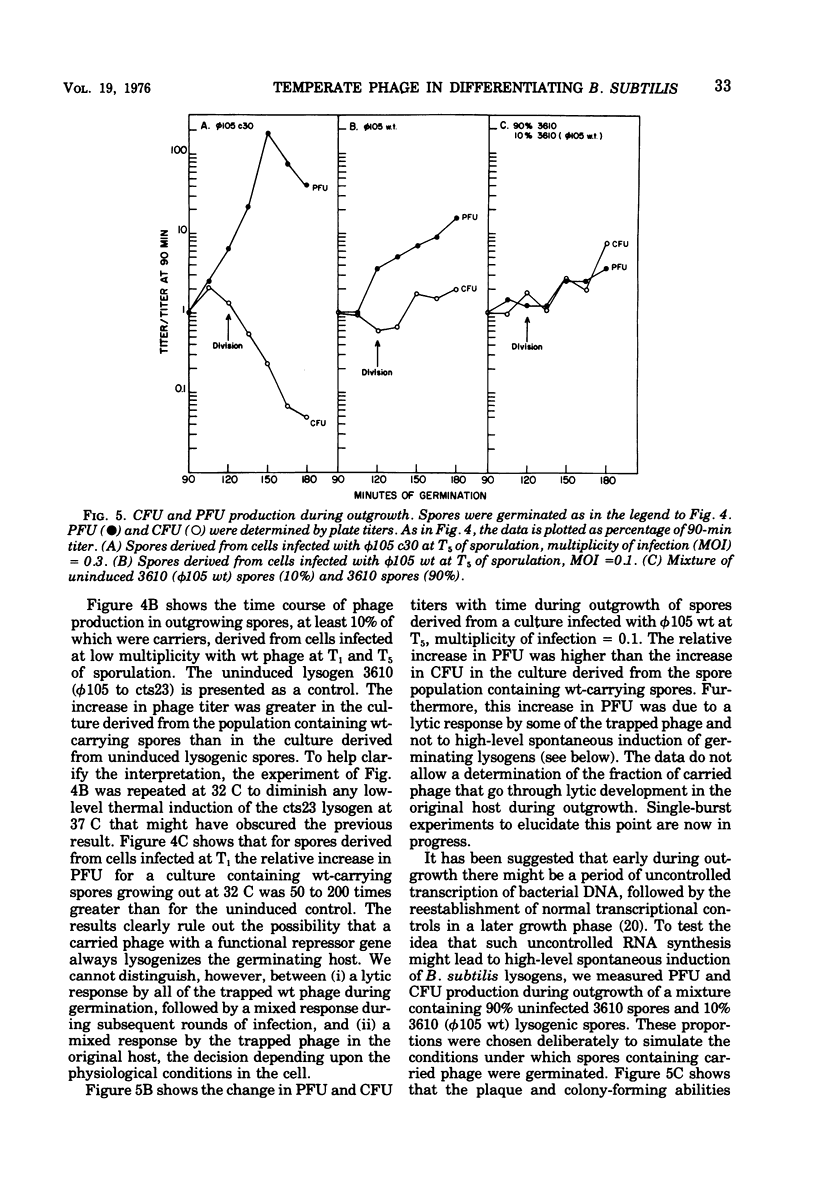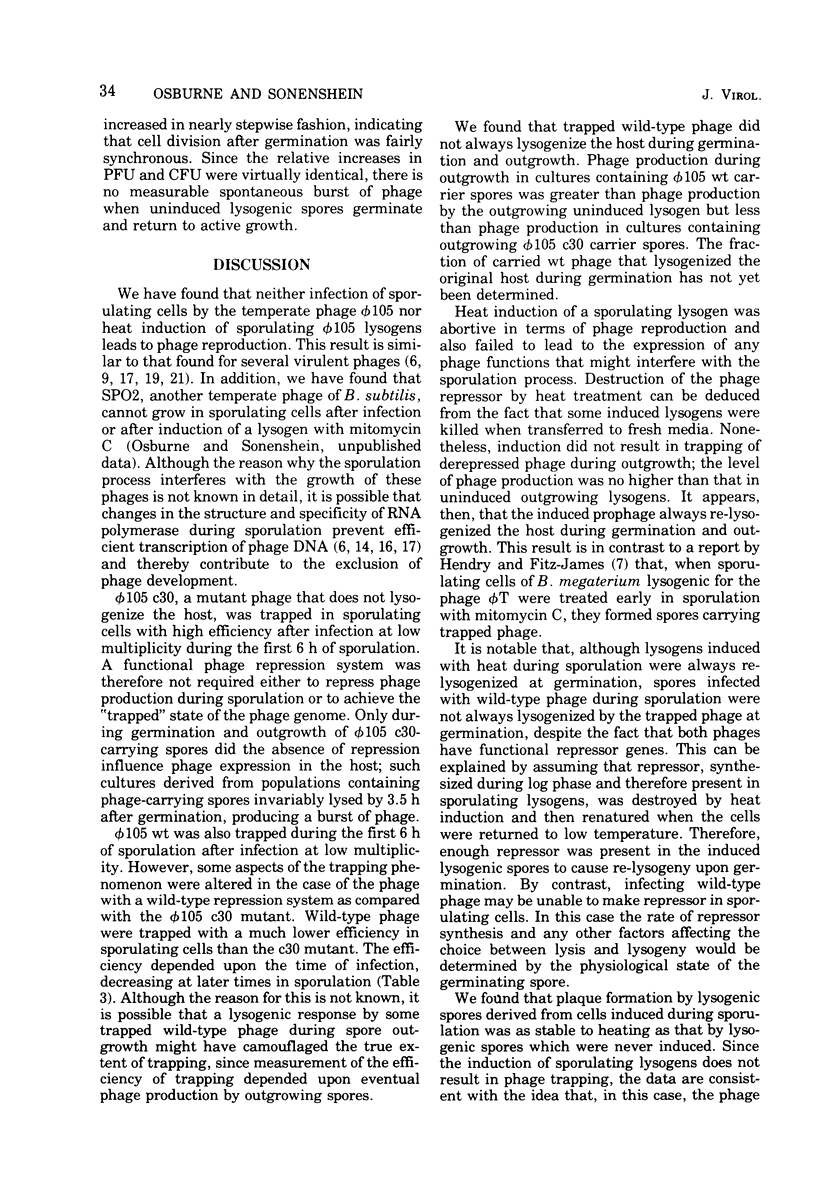Abstract
During the first 6 hr of sporulation, infection of Bacillus subtilis by by phi105 wild type or the clear-plaque mutant phi105 c30 was nonproductive, but phage DNA was trapped inside developing spores. After infection with either wild-type or mutant phage at early times of sporulation (T1-T3), phage DNA entered the developing spores in a heat-stable form, which may represent integration of the phage DNA into the host chromosome. Phage DNA in carrier spores produced by infection at later times (T4-T6) was much more heat sensitive. Spore preparations containing either phi105 wild type or phi105 c30 carrier spores gave rise to a spontaneous burst of phage during outgrowth, although the fraction of carried wild-type phage that chose lysis over lysogeny at germination has not been determined. Heat induction of the thermoinducible lysogen 3610 (phi105 cts23) was also abortive during sporulation. Furthermore, induction neither prevented eventual spore formation nor resulted in the conversion of prophage DNA to the carrier state; during outgrowth, the previously induced lysogenic spores remained stable lysogens. However, if the sporulating lysogenic cells were plated immediately after induction, they did not form colonies at high efficiency, as though transfer to fresh medium allowed sufficient phage expression to kill the host.
Full text
PDF









Selected References
These references are in PubMed. This may not be the complete list of references from this article.
- Armentrout R. W., Rutberg L. Heat induction of prophage phi 105 in Bacillus subtilis: replication of the bacterial and bacteriophage genomes. J Virol. 1971 Oct;8(4):455–468. doi: 10.1128/jvi.8.4.455-468.1971. [DOI] [PMC free article] [PubMed] [Google Scholar]
- Birdsell D. C., Hathaway G. M., Rutberg L. Characterization of Temperate Bacillus Bacteriophage phi105. J Virol. 1969 Sep;4(3):264–270. doi: 10.1128/jvi.4.3.264-270.1969. [DOI] [PMC free article] [PubMed] [Google Scholar]
- Buu A., Sonenshein A. L. Nucleic acid synthesis and ribonucleic acid polymerase specificity in germinating and outgrowing spores of Bacillus subtilis. J Bacteriol. 1975 Oct;124(1):190–200. doi: 10.1128/jb.124.1.190-200.1975. [DOI] [PMC free article] [PubMed] [Google Scholar]
- Cohen A., Ben-Ze'ev H., Yashouv J. Outgrowth of Bacillus cereus spores harboring bacteriophage CP-51 DNA. I. Initiation of bacteriophage development. J Virol. 1973 May;11(5):648–654. doi: 10.1128/jvi.11.5.648-654.1973. [DOI] [PMC free article] [PubMed] [Google Scholar]
- Hendry G. S., Fitz-James P. C. Exclusion of induced bacteriophage from cells of a lysogenic Bacillus megaterium committed to sporulation. J Bacteriol. 1974 Apr;118(1):295–303. doi: 10.1128/jb.118.1.295-303.1974. [DOI] [PMC free article] [PubMed] [Google Scholar]
- Kawamura F., Ito J. Bacteriophage gene expression in sporulating cells of Bacillus subtilis 168. Virology. 1974 Dec;62(2):414–425. doi: 10.1016/0042-6822(74)90403-6. [DOI] [PubMed] [Google Scholar]
- Roscoe D. H., Tucker R. G. The biosynthesis of 5-hydroxymethyldeoxyuridylic acid in bacteriophage-infected Bacillus subtilis. Virology. 1966 May;29(1):157–166. doi: 10.1016/0042-6822(66)90205-4. [DOI] [PubMed] [Google Scholar]
- Rutberg L., Hoch J. A., Spizizen J. Mechanism of transfection with deoxyribonucleic acid from the temperate Bacillus bacteriophage phi-105. J Virol. 1969 Jul;4(1):50–57. doi: 10.1128/jvi.4.1.50-57.1969. [DOI] [PMC free article] [PubMed] [Google Scholar]
- Rutberg L. Mapping of a temperate bacteriophage active on Bacillus subtilis. J Virol. 1969 Jan;3(1):38–44. doi: 10.1128/jvi.3.1.38-44.1969. [DOI] [PMC free article] [PubMed] [Google Scholar]
- SEAMAN E., TARMY E., MARMUR J. INDUCIBLE PHAGES OF BACILLUS SUBTILIS. Biochemistry. 1964 May;3:607–613. doi: 10.1021/bi00893a001. [DOI] [PubMed] [Google Scholar]
- Shapiro J. A., Dean D. H., Halvorson H. O. Low-frequency specialized transduction with Bacillus subtilis bacteriophage phi 105. Virology. 1974 Dec;62(2):393–403. doi: 10.1016/0042-6822(74)90401-2. [DOI] [PubMed] [Google Scholar]
- Sonenshein A. L., Cami B., Brevet J., Cote R. Isolation and characterization of rifampin-resistant and streptolydigin-resistant mutants of Bacillus subtilis with altered sporulation properties. J Bacteriol. 1974 Oct;120(1):253–265. doi: 10.1128/jb.120.1.253-265.1974. [DOI] [PMC free article] [PubMed] [Google Scholar]
- Sonenshein A. L., Roscoe D. H. The course of phage phi-e infection in sporulating cells of Bacillus subtilis strain 3610. Virology. 1969 Oct;39(2):265–275. doi: 10.1016/0042-6822(69)90047-6. [DOI] [PubMed] [Google Scholar]
- Spiegelman W. G. Two states of expression of genes cl, rex, and N in lambda. Virology. 1971 Jan;43(1):16–33. doi: 10.1016/0042-6822(71)90220-0. [DOI] [PubMed] [Google Scholar]
- TAKAHASHI I. INCORPORATION OF BACTERIOPHAGE GENOME BY SPORES OF BACILLUS SUBTILIS. J Bacteriol. 1964 Jun;87:1499–1502. doi: 10.1128/jb.87.6.1499-1502.1964. [DOI] [PMC free article] [PubMed] [Google Scholar]
- Torriani A., Levinthal C. Ordered synthesis of proteins during outgrowth of spores of Bacillus cereus. J Bacteriol. 1967 Jul;94(1):176–183. doi: 10.1128/jb.94.1.176-183.1967. [DOI] [PMC free article] [PubMed] [Google Scholar]
- Yehle C. O., Doi R. H. Differential expression of bacteriophage genomes in vegetative and sporulating cells of Bacillus subtilis. J Virol. 1967 Oct;1(5):935–947. doi: 10.1128/jvi.1.5.935-947.1967. [DOI] [PMC free article] [PubMed] [Google Scholar]


